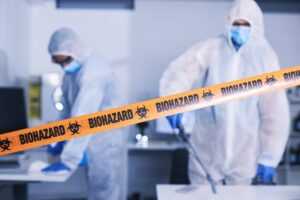A crime scene creates a chaotic environment that distracts you from what’s to come after everyone has left and the scene has settled. You’re left with a cleanup job that includes biological waste, which turns the room into a hazardous environment. Chances are good that you’re not equipped to deal with the requirements of a crime scene cleanup and are unsure where to start.
Almost no one is prepared to take on the cleaning of a crime scene. It’s not something that most people ever encounter in their lifetime. For those who have to deal with the aftermath of a crime scene, unattended death, or trauma scene, it’s difficult to know where to start.
At ZBM Inc. in Watertown, WI, we’re here to help you address the aftermath of the incident and restore your property to its original condition. Here’s a look at how we can help you recover from a difficult situation and work on getting back to normal.
What Is a Crime Scene Cleanup?
A crime scene cleanup involves professional cleaners wearing biohazard garments and using professional-grade biohazard waste cleaners. This enables them to put their strongest efforts towards cleaning up blood, tissue, and other organic materials that are left behind. It also enables them to get into hard-to-reach spots and areas that are often overlooked in search of biohazardous waste that shouldn’t be left behind. The overall goal of crime scene cleanup is to restore the affected area to its original condition and make it safe for occupancy.
The Steps Involved in Conducting a Crime Scene Cleanup
In order to perform an effective cleaning operation, the scene has to be evaluated to determine what needs to be done. Afterward, the cleanup crew can begin their restoration work and bring the room or area back to a state that’s safe for occupancy once again. The following is a general overview of what goes on during a crime scene cleanup.
Evaluation of the Scene
An evaluation of the scene is necessary before the work gets started. The person doing the evaluation takes note of the types of biohazardous materials that are found on the scene, how many rooms are affected, the size of the scene, and what’s been affected. All the information that’s collected is used to determine what kind of cleaning materials and tools are necessary to get the job done right. It’s also used to give you an estimate of the cost of cleanup.
Initial Cleanup
It’s rare for a crime scene to result in an organized setting and is most often a mess of overturned objects and damaged items. The cleanup crew needs to remove obstacles out of their way in order to get to the biohazardous material. Anything that has been broken, damaged, or otherwise affected by the criminal event is removed in a contained manner and taken out for disposal. The goal is to prevent further contamination of the property, which will require more cleanup effort.
Some items may be recoverable and made safe again, but it depends on the item and the cleaner’s assessment of whether it’s salvageable. You can ask about the possibility of saving an item during the evaluation. It’s best to be prepared for the loss of items that were affected by the events.
Surface Cleaning
Once all the major obstructions are out of the way, the cleaning crew seeks out places where blood has seeped into and where tissues have landed. This is a gruesome task, but it’s necessary if the scene is to be made safe once again. Blood pools and seeps into cracks in the floor, soaks into fabrics, and spatters on walls. Removing the blood is of the utmost importance, and the cleaners use cleaning agents that completely remove the blood from the surface.
The crew also looks for tissue that landed on surfaces throughout the location for sanitation and prevention of unwanted odors. Blood and tissue will decay over time, and leaving anything behind results in a foul odor that is an unpleasant reminder of the event. The crime scene cleanup crew is well aware of the potential issues, which means they put high-level effort into the total removal of the biohazards.
Insect Cleanup
Insects are another issue that is sometimes present at a crime scene, especially if time has passed between the events and their discovery. Flies are especially prevalent due to their rapid breeding, and make a room become flyblown. The cleanup crew deals with the flies by clearing them out of the room, removing dead ones, and removing all materials that can be used for breeding.
Destruction of Pathogens
Blood, body fluids, and tissues are all potential sources of viruses and bacteria. Leaving any trace of these behind can result in the contraction of an infection or disease if someone comes into contact with something that was left behind. Proper cleanup prevents the risk of infection through unintended contact, but it doesn’t stop at the removal of these sources.
The use of professional-grade cleaning fluids and materials has been proven to destroy the pathogens that are left behind after biohazards are removed. Our crime scene cleanup crew is equipped with the best cleaning disinfectants that are designed for the purpose of destroying the pathogens that are left behind. The end result is returning your property to a place that’s safe to use once again.
Furniture Removal
In the event furniture has been affected by the events, the cleanup crew will seal the item in plastic to prevent biohazardous material from dripping, then remove it from the premises. The item is loaded onto a truck for removal and taken to a facility for safe disposal.
Call Us at ZBM Inc. Today for Help With a Crime Scene Cleanup
A crime scene can happen anywhere, and we’re equipped to deal with the aftermath no matter the situation. Our team of professional cleaners is ready to come to your home, office, or commercial business to get the job done. We’ll remove everything from blood to the waste that’s left behind by EMS and neutralize the biohazard. That way, you don’t have to worry about coming into contact with something that can transmit bacteria and viruses. Give us a call at 920-262-9471 today for a free estimate and get started on returning your property to normal.


